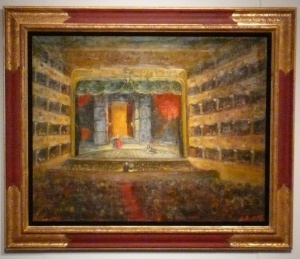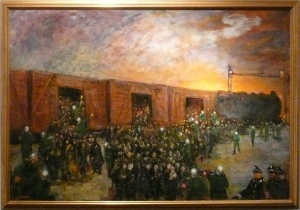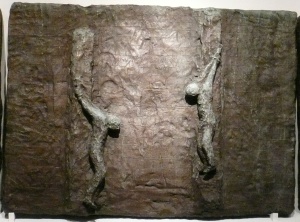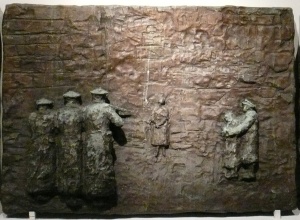Arbit Blatas: Centennial Tribute
Barbarism cannot triumph. This is what we believe, as Jews and as Americans. And yet it did a mere seventy years ago in the very heart of what was considered the cultural capital of Europe, Germany and Austria. The rich cultural milieu that produced the music of Bach, Beethoven, Mozart, Wagner, Brahms, and Strauss, and the pictorial masterpieces of Durer, Holbein and Cranach was inexplicably the birthplace of Hitler’s Nazism and his murderous jackals. In some mysterious way the artwork of Arbit Blatas (1908-1999), currently seen in a centennial tribute at the Hebrew Union College Museum, holds this conundrum in a kind of uneasy balance.
The exhibition is divided into two parts: one that displays the artist’s harmonious and charming School of Paris paintings and the other that presents his Monument to the Holocaust. First there are beautiful depictions of set designs for operatic productions in all the major opera houses interspersed with poetic scenes of Paris and Venice. Taken as a group it is an evocation of European civilized living at its best, a good life filled with color, light and fresh air that cherishes music, drama, and a calm appreciation of life’s pleasures.
As you walk through the door into the interior gallery the mood and substance suddenly changes drastically. You have entered the Holocaust. On the far walls one is confronted with four large paintings: The Last Train, The Deportation, The Quarry, and Babi Yar. Closer are a powerful series of seven bas-relief bronze sculptures, Monument to the Holocaust. Since the early 1980s these works have been installed in the Ghetto in Venice as well as in the Shrine of the Unknown Jewish Martyrs in Paris and, until recently, in Dag Hammarskjöld Plaza at the UN in New York. Another version of his holocaust memorial was recently erected in the city of Kaunas, Lithuania, the artist’s birthplace.
Arbit Blatas was born in Kaunas, also known as Kovne, very near the famous center of Jewish learning, the Slobodka Yeshiva. Early on he showed considerable talent in the arts and in 1928 made his way to Paris where he immediately became part of what was later known as the School of Paris. He rubbed shoulders and painted the portraits of many of the most famous artists of the early 20th century including Picasso, Matisse, Braque, Leger, Bonnard and Dufy, not to mention the Jewish émigré artists including Chagall, Sonia Delannay, Mani-Katz, Lipchitz, Modigliani, Pascin, Soutine and Weber. He painted, exhibited and prospered.
He was able to escape the advance of the Nazis in Europe in 1941 and, arriving in America, quickly became a member of the New York art community, eventually exhibiting in many prominent galleries including Pierre Matisse Gallery, Associated American Artists and Hirshl & Adler. After the war he began to divide his time between New York, Paris and Venice.
Eventually Blatas married the world-renowned mezzo-soprano Regina Resnik and collaborated with her in stage and costume design as she took on the additional role of stage director. Together they created productions of Carmen, Falstaff, Queen of Spades, Salome and Elektra for many of the grand opera houses all over the world. Most of the opera design paintings seen in this exhibition are from this period of his life.
The set designs are simply composed scenes in naturalistic settings palpably waiting for the singers and chorus to arrive. His depiction of Act 4 from Carmen shows the imposing façade of the bullring sharply contrasted to a bright airy plaza festooned with banners and ornate buildings in the distance. It is the perfect setting for the final scene where Carmen is stabbed to death by her jealous ex-lover as her true love, the matador, is heard triumphant inside the arena.

Other impressive theatrical paintings include a depiction of the interior of the Teatro la Fenice in Venice in performance of Elektra by Richard Strauss. The lush golden interior of the venerable opera house frames the scene of the performance in progress, creating a nostalgic but thrilling recreation of a dramatic triumph.
These works and others from the other post-war period display a School of Paris painterly sensibility that expresses a great love of beautiful light, soft and harmonious colors and a contented and civilized sensibility. Life is beautiful, food is plentiful and cultured entertainment is just around the corner. The contrast with the Holocaust Memorial could not be greater.
The four oil paintings echo the grim subjects of the relief sculptures, offering similar visions with red angry skies and stark tonal contrasts. Babi Yar, the earliest of these was painted in 1944, and is the most expressionistic; anonymous figures struggling, chaotic, herded and beaten by two murderous guards. An angry crimson orb hovers in the sky above the massacre.
In The Deportation most of the figures are faceless with the exception of an old grandfather, tattered suitcase in hand, who seems to gaze accusingly at the German soldier guarding the mass of Jews. An enormous locomotive lurks in the background.
The Final Solution places a German officer and two soldiers in the immediate foreground ready to machine-gun a waiting crowd of naked captives in the middle ground. An indistinguishable mound of bodies takes up half the space between murderers and victims. The overwhelming anonymity of the scene makes it even more unbearable.

Perhaps the most powerful image is The Last Train, three gaping boxcar doors spewing human cargo into the ruthless arms of the Gestapo. The simplicity of the composition: three sienna brown boxcars behind an amorphous grey locomotive, dots of green guard uniforms and two distinct masses of Jews, makes the horrible reality somehow visually understandable, all the more to shock the consciousness of the viewer.
The bronze reliefs are paradoxically yet more brutal. I have seen them many times in Venetian Ghetto and in that outdoor context, because of the diffuse natural light, they have always been difficult to see. In the gallery here in New York they present a much more memorable presence. The course nature of the bronze medium creates the immediacy and passion of the subject. The figures become even more indistinct, forcing the viewer to visually probe the surface for clues as to what is actually occurring. That which is relatively clear in the paintings, the relief sculpture abstracts and breaks up into raw angry metal. The effect is decidedly unsettling.

Two of the reliefs are terrifyingly clear. The Punishment brings the brutality of the Holocaust down to a very personal level. Two standing figures are tied to posts with their arms tied together behind them, excruciatingly forced to endure constant pain, exposure and humiliation. The motif of the wall behind them emphasizes the placement of these sculptures on barren brick wall in the large open courtyard of the Venetian Ghetto.

Execution in the Ghetto confronts us with the horror of one Jew’s death. In the foreground there are three gunmen in the firing squad, then to the right two figures, an officer forcing a person to watch (a surrogate for us) and finally one lone figure, hands tied and ready to die. Three, two, one, the space is collapsed so that each group confronts the others in an intimate moment of horror. While the seven relief sculptures that make up the Blatas Holocaust Memorial never directly reference the brutality that occurred in the Venetian Ghetto; the round ups, deportations and finally the death of 200 Venetian Jews in the camps, this one image manages to bring it all home for the Jewish community in Venice.
In 1978 Arbit Blatas went to his Venetian studio and started work on these relief sculptures, allegedly working for forty days straight until they were ready to be cast in bronze. He and his wife Regina Resnik then approached the City of Venice and the Jewish Community and offered to donate them. Thankfully the community accepted and they were installed in the Ghetto in 1980. He continued for years to produce his “School of Paris” paintings, pleasant visual meditations on the pleasures of a civilized life. Only occasionally did he return in painting or sculpture to the Holocaust.
One hopes that for Blatas life was pretty good, filled with friends, culture and artistic success, which he and all of us have every right to enjoy. But still beneath it all, he could not forget when Europe became barbaric, murdering six million of his people, including his mother in the Nazi concentration camp at Studhof and, ultimately from his experience in Dachau, his father, too. Blatas was a survivor whose artwork manages to hold together two terribly contradictory sensibilities: Culture and barbarism.
What this exhibition makes abundantly clear is that Arbit Blatas’s work, all aspects of it, never allows us to forget.
Arbit Blatas: Centennial Tribute
Hebrew Union Collage – Jewish Institute of Religion Museum
One West 4th Street, New York, NY 10012; 212 824 2205
Mon. – Thurs. 9am – 5pm; Friday, 9am – 3pm.
Free Admission (Photo ID required)